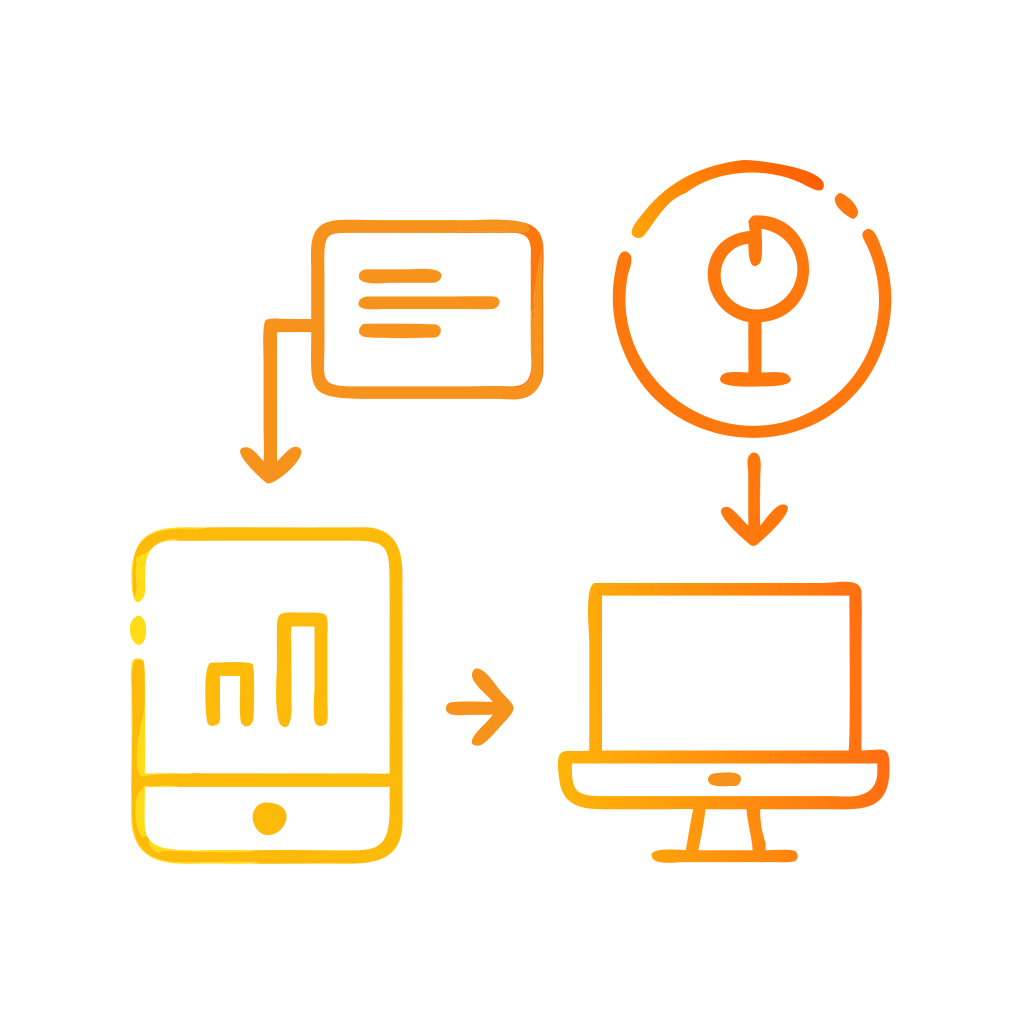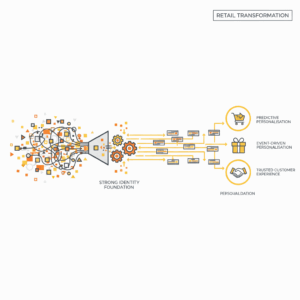Identity foundations transform retail personalisation when leaders measure what matters and fix the sources of identity fragmentation. Organisations unify consented identifiers, stabilise household keys, and govern profile attributes so every channel can recognise the same customer with the right level of confidence. Strong identity foundations reduce duplicate records, lift match precision, and create the preconditions for predictive, event-driven personalisation that customers trust.¹ ³
What problem did the retailer face in 2025 and how did evidence shape the response?
The retailer faced stalled personalisation despite heavy investment in features and campaigns. Digital adoption plateaued and service costs rose because product teams optimised features rather than customer progress. Leaders reframed the work around customer jobs and used identity diagnostics to expose where sign-in friction, duplicate profiles, and inconsistent preferences undermined task success. Evidence showed that customers now expect relevant experiences across channels and switch when expectations are not met, which made identity reliability a strategic imperative.¹ ³
How do identity and data foundations enable reliable recognition across channels?
Identity foundations align loyalty IDs, e-commerce accounts, and in-store tenders under a governed customer graph. Teams define durable person and household keys, standardise profile attributes, and enforce consent state as a first-class field. Clean keys allow the same shopper to be recognised during store pickup, website reorder, and mobile notifications without brittle workarounds. The foundation stores occasion and mission signals as derived features, which improves targeting for replenishment, top-up, or dinner-for-four trips.³
Which metrics show match quality and why do they matter to personalisation?
Match quality needs transparent metrics so executives can steer. Precision shows how many linked identities are correct. Recall shows how many true links have been found. F1 balances both. False positives and false negatives quantify harm to experiences. Completeness shows whether profiles hold the attributes required to power offers and service. Duplicate suppression ratio shows how much noise the foundation removes. These measures connect identity work to tangible customer outcomes and reduce vanity focus on raw match rate alone.¹ ³
How did analytics operationalise identity measurement and accelerate fixes?
Analytics operationalised identity by instrumenting dashboards that exposed duplicate rates, profile completeness, and improvements after cleansing cycles. Leaders correlated identity quality with adoption metrics and mission outcomes to prioritise investment. Real-time views made identity work visible to product, marketing, and service teams so changes could be tested, reversed, and scaled quickly. Teams used governed, first-party data to avoid over-personalisation risks while still delivering relevance customers value.¹ ³
→ Improve real-time visibility with Customer Science Insights for contact centre and CX analytics, including data pipeline health and KPI tracing for identity-dependent experiences. (https://customerscience.com.au/csg-product/customer-science-insights/)
What interventions delivered the fastest lift in personalisation quality?
The team simplified sign-in with risk-based checks, introduced progressive profiling for low-friction attribute capture, and stitched store and digital identities to pre-fill pickup contacts and default payments for known customers. The team also aligned event schemas to job stories so the system could recognise when a shopper aimed to repeat a known basket or complete a time-critical mission. Designers removed optional steps for known customers and added a “Finish my order” control that used saved baskets and one-tap confirmation for identical reorders. These interventions reduced effort and lifted conversion on priority journeys.¹
How did knowledge governance sustain identity accuracy at scale?
Knowledge governance sustained identity accuracy by standardising definitions, validating content, and monitoring drift in articles, templates, and taxonomies that drive communications and support flows. A managed knowledge layer reduced template drift and ensured that identity-sensitive content, such as verification instructions and preference management explanations, stayed aligned with policy and consent. Tighter governance prevented unintended variations that confuse customers and create repeat contact.²
→ Strengthen knowledge health and authoring discipline with Knowledge Quest to manage definitions, templates, and policy-aligned content that underpin identity experiences. (https://customerscience.com.au/csg-product/knowledge-quest/)
How did research and design methods prove value and reduce risk?
CX research and design methods grounded decisions in behavioural evidence. Discovery interviews, task-based usability tests, and in-store intercepts quantified effort, time on task, and error states for identity-heavy flows such as account creation, saved payment use, and click-and-collect. Researchers validated whether personalisation felt helpful or intrusive, and they documented explicit consent patterns that built trust. This discipline linked identity metrics to customer outcomes and provided a defensible case for investment.¹ ³
→ Apply structured discovery and measurement through CX Research & Design to link identity quality to adoption, satisfaction, and value. (https://customerscience.com.au/solution/cx-research-design/)
Which risks did the program manage to protect trust and outcomes?
The program managed over-automation risk by preserving staffed options and escalation paths for exceptions. The team constrained personalisation creep through explicit consent, transparent preference centres, and channel-consistent choices. The team maintained fairness by auditing who received high-value recommendations by mission and household, and it validated opt-out and deletion flows. Identity and data foundations enabled these guardrails because clean keys and consent states travelled reliably between channels.³
What results did executives observe and how were they measured?
Executives observed higher task success, improved basket outcomes, and visible reductions in friction on identity-heavy flows. The grocer use case showed that occasion-aligned targeting grew average items per basket and cross-category penetration while maintaining auditability. The retailer adoption case showed that re-framing around customer jobs and stabilising identity foundations unlocked adoption where feature delivery alone had stalled. These results created a repeatable model for measuring identity quality and personalisation value across portfolios.¹ ³
What should leaders do next to replicate these results?
Leaders should write five job stories that describe the progress customers seek in priority missions. Leaders should align identity schemas and event tracking to those job stories so each release has a measurable intent. Leaders should instrument dashboards that tie match quality to mission outcomes and set thresholds for reversibility and audit. Leaders should establish knowledge governance to prevent drift in identity-sensitive content. Leaders should run controlled experiments that compare mission conversion with and without identity-enabled features so value remains provable and safe to scale.¹ ³
FAQ
What is an identity foundation in retail and why is it essential for personalisation?
An identity foundation is the governed set of keys, attributes, consent states, and derived features that reliably recognise a customer across channels. It enables accurate pre-fill, mission detection, and relevant offers that reduce effort and lift conversion.³
How do retailers measure identity match quality in practice?
Retailers track precision, recall, F1, false positive and false negative rates, completeness, and duplicate suppression ratio. These metrics connect identity work to adoption, conversion, and service outcomes rather than vanity rates.¹ ³
Which quick wins typically lift personalisation quality?
Teams simplify sign-in, enable progressive profiling, pre-fill known fields, and expose saved baskets with one-tap confirmation for repeat orders. These changes reduce effort on identity-heavy journeys and lift conversion.¹
Which Customer Science product helps monitor identity-dependent KPIs?
Customer Science Insights provides real-time analytics for data pipelines and CX KPIs so leaders can correlate identity quality with mission outcomes. (https://customerscience.com.au/csg-product/customer-science-insights/)
How does knowledge governance protect identity accuracy and trust?
Knowledge governance standardises definitions, validates templates, and prevents drift in identity-sensitive content. Consistency reduces confusion, lowers repeat contact, and protects consent integrity.²
Which service helps validate customer impact before scaling personalisation?
CX Research & Design uses structured discovery, testing, and measurement to link identity improvements to behavioural and emotional outcomes, which reduces risk and improves adoption. (https://customerscience.com.au/solution/cx-research-design/)
Sources
Case Study: retailer improves adoption with JTBD insights (2025) — Customer Science, 2025. (Customer Science)
Case Study: 40% Email Deflection via Triage AI — Customer Science, 2025. (Customer Science)
Case Study: grocer boosts basket size with occasion analytics (2025) — Customer Science, 2025. (Customer Science)
Note: Additional company background and contact details are available on the Customer Science site if needed for publication metadata. (Customer Science)































